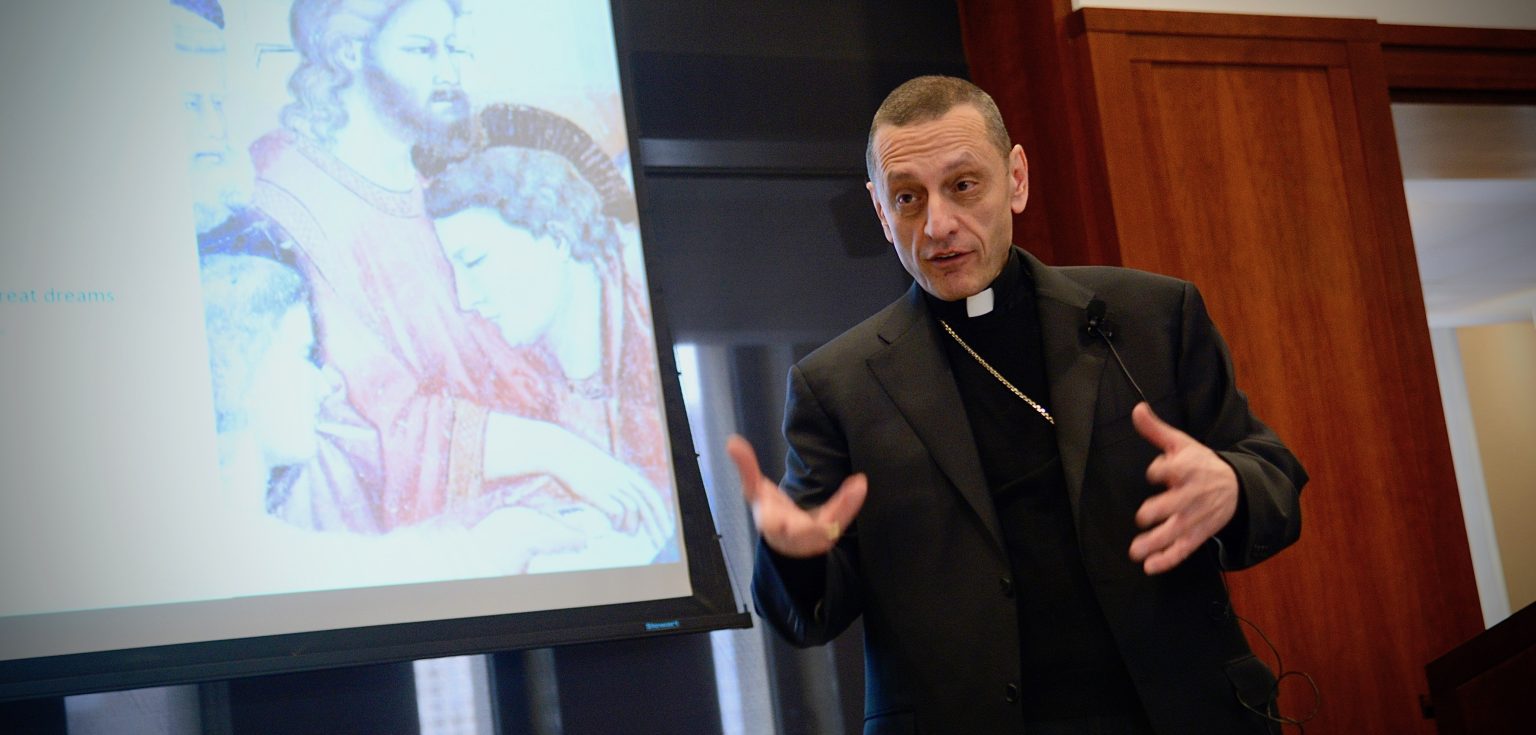“There are questions unresolved, and young people simply don’t have the mental energy or desire to figure it out,” said Bishop Caggiano. “And so they walk away.”
Speaking at an event called Passing on the Faith, sponsored by the Graduate School of Education’s Center for Catholic School Leadership and Faith-Based Education, Bishop Caggiano talked about the reasons young people are leaving the church now more than ever, their changing pathways to vocation and the Catholic faith, and what Catholic educators can do to help the next generation stay engaged.
His lecture was largely a reflection on what he learned at the 2018 synod in Rome on “Young People, the Faith, and Vocational Discernment”—an assembly of bishops from around the world who, with Pope Francis, discussed how to minister to today’s teenagers and young adults.
Eroded Trust and Unresolved Answers
“Disaffiliation in the United States is beginning [as early as] the age of 7,” Bishop Caggiano, said, citing numbers from a 2018 national study conducted by Georgetown University and Saint Mary’s Press. When disaffiliated Catholic youth—those aged between 15 and 25—were asked at what age they no longer identified themselves as Catholic, 74 percent of the surveyed group said between the ages of 10 and 20.
Part of the blame lies on the many problems plaguing our world today, Bishop Caggiano said. Among them are the “abuse of minors and vulnerable adults,” especially in the church; “polarization”; and lack of “dialogue.” Such issues, he said, have “destroyed many young people’s lives and created this vacuum of trust, particularly with the leadership of the church.”
Their trust has eroded in other ways, too.
“Affiliation occurs when a relationship is built up over time, precisely by questions that are answered satisfactorily,” Bishop Caggiano said. He compared it with falling in love.
“There are a thousand questions that come to mind: Is he or she the real deal? Can that person be trusted?” Bishop Caggiano said.
It works the same way with disaffiliation. Young people and young adults ask religious figures many questions, Bishop Caggiano said. But often, those questions are left unresolved. They pile up. And, just as wood chips away over years, so too does their affiliation for the faith.
The Art of Listening, Accompanying, and Mentoring
Bishop Caggiano urged his audience of Catholic educators—principals and superintendents from local archdioceses and dioceses, administrators from Catholic secondary schools, campus ministry staff who serve at Fordham and nearby high schools, and GSE students—to think about three things he learned from the 2018 synod.
First, if you listen deeply to young people and young adults, he said, you can open a real dialogue. Second, accompany them on their journey, even if you might be on the wrong path. And third, make sure you are a mentor worth following.
Listening isn’t the same thing as hearing, he began.
“It’s not what we have learned—keeping your mouth closed until somebody else finishes talking, and then saying what you were gonna say, regardless of what they [the other person] said,” Bishop Caggiano said in his native Brooklyn accent, while the audience laughed.
“You listen with your mind and ears; you listen with your heart,” he said. That means you not only hear a person speak but also pay attention to their body language—their facial expression, posture, the words not spoken.
And, he added, that also means letting them be heard.
“How much do you place into your ministry the importance of allowing them to raise their questions without prejudice?” he asked. “How often do you and I allow that to happen in a safe space?”
Lesson number two: Accompany young people along their journey to Christ. One way to do that, Bishop Caggiano said, is to consider the younger generation’s appreciation for the beauty of the liturgy. He asked the audience to think about how to intentionally incorporate beauty in their teaching—music, art, architecture, and literature—and showcase the cultural diversity of the church.
“When one experiences beauty, there is this natural, unfolding, opening of the heart to embrace it,” he said.
Lastly, the bishop reminded them of the importance of mentorship.
“We need to find better and more diverse ways,” Bishop Caggiano told the Catholic educators in the room. “To allow these young people and young adults to answer the call—to explore the greatness of what it means to be a human being.”


